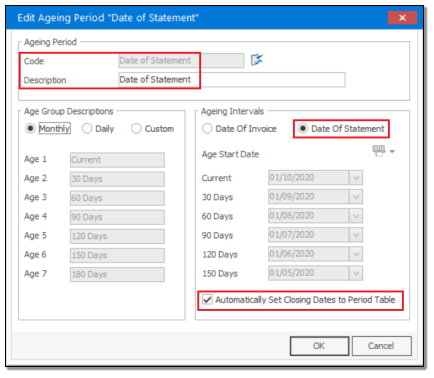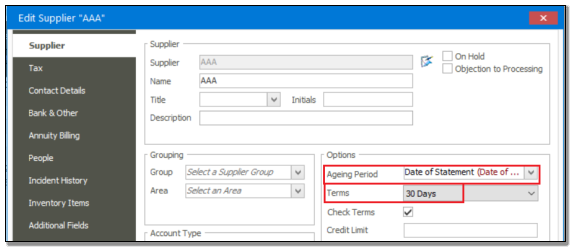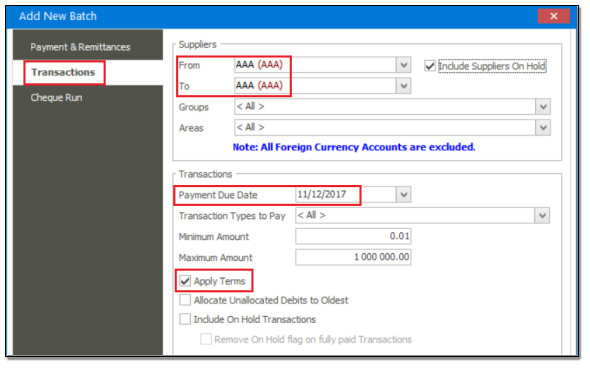Article credit: Sage
This article discusses the most significant factors that determine if a Supplier Invoice (SINV) is included or excluded from the Automatic Payments and Remittances batch.
Please also note:
This article doesn’t focus on the obvious, logical filters as selected/applied on the Automatic Payments and Remittances batch that determine if a certain SINV is included or excluded. Instead it focusses on especially the relationship between the Supplier’s Terms, Supplier’s Ageing period and the Automatic Payments and Remittances batch Payment Due Date.
First consider the following scenario to explain further.
1. Go to Suppliers | Maintenance | Ageing Periods and create a supplier ageing period with an ageing interval of Date of Statement and select the option: Automatically set closing dates to period table
2. Create a new supplier AAA as linked to the above created Ageing Period & set the supplier Terms = 30 Days.
3. Process the following Supplier Invoices (SINV) for supplier AAA:
- 01 September 2017 – R 1 000.00 inclusive
- 01 October 2017 – R 1 000.00 inclusive
- 01 November 2017 – R 3000.00 inclusive
- 01 December 2017 – R4 000.00 inclusive
4. Go to Suppliers | Transactions | Automatic Payments & Remittances batch and create a new batch as below:
- On the Payment and remittances tab, select the Cheque Run/None option on the Payment Run section at the bottom of the screen.
- On the Transactions tab:
- Supplier From and To fields = AAA
- Payment Due Date = 11 December 2017
- Apply Terms option selected
- When done, click the OK button to save the new batch.
5. Open the batch and then drill down on the batch to supplier AAA’ transactions. Only these three transactions display as due for payment, correct and as expected
- 01 September 2017 – R 1 000.00 inclusive
- 01 October 2017 – R 1 000.00 inclusive
- 01 November 2017 – R 3000.00 inclusive
The Invoice for 01 December 2017 is correctly excluded above as it is regarded as Current in this case in the context of the relationship between the Payment Due Date, SINV date and the supplier’s Terms to be 30 Days.
6. Close the batch, find and open/edit Supplier AAA
7. In here change the Supplier’s Terms to Current and save the change.
8. Re-open the Automatic Payments & Remittances batch.
9. Again, drill down on the batch to supplier AAA’ transactions.
10. You should now notice that all the processed supplier invoices display. The 1 Dec 2017 SINV is included this time as it is now considered as Current according to the relationship between the Batch Payment Due Date (01/12/2017), SINV date and the Supplier’s Terms = Current
11. Now process a new SINV for AAA on 25 November 2017 for R5 000.00
12. Change the terms back to 30 Days on the supplier account.
13. Delete the current Automatic Payments & Remittances batch.
14. Create a new Automatic Payments & Remittances batch the same way as in step 4 above, except for: on the Transactions tab do not select the ‘Apply Terms’ option.
15. When you open the batch and drill down on supplier AAA’s transactions you will notice the SINV processed on 25 November 2017 displays which is correct.
16. Delete the current Automatic Payments & Remittances batch.
17. Create a new Automatic Payments & Remittances batch the same way as in step 4 above. This time on the Transactions tab, select the Apply Terms’ option.
18. When you open the batch and drill down on supplier AAA’s transactions you will notice the following:
- The SINV processed on 1 December 2017 is excluded as expected. Its exclusion is correct as it falls within the 30 Days Terms of the Supplier in relation to the Batch Payment Due Date and is therefore not yet due for payment.
- The SINV processed on 25 November 2017 is included and it is the inclusion of this SINV that may be regarded as unexpected and incorrect.
19. This is due to the user’s possible perception that this SINV’s date also falls within the supplier’s 30 days Terms of the period starting from the batch’ Payment Due Date of 11/12/2017 (thus, 11/12/2017 plus 30 days = 11/01/2018). That means a SINV with date (25/11/2017) should therefore be excluded from the batch in this case. You may therefore believe this matter to be the result of a software bug.
Resolution
First note that the above discussed inclusion of the 25/11/2017 SINV is not due to a software bug and it works correctly according to Evolution’s design.
The following rationale explains why:
Scenario:
- Ageing Period: Date of Statement
- Terms: 30 Days Terms
With Supplier Terms of 30 Days Terms, the SINV of 25/11/2017 will be due for payment from 01/12/2017 which is the first day of the month following the SINV date.
The primary factor to consider in this case is the supplier’s linked Ageing Period of Date of Statement.
This Ageing Period type (Date of Statement) resets the determination of when an invoice is due for payment at the start of the number of months as determined by the linked Supplier Terms.
Using Supplier Terms = Current:
- Regardless the specific SINV’s day within the 1st month of the SINV transaction (e.g. 25th in this case) from the SINV transaction date, the SINV is immediately due for payment.
- That means with the Automatic PM and Remittance batch Payment Due Date = 1 Dec 2017 or any date in December 2017,
- the SINV of 25 Nov 2017 is already due (since 25 Nov 2017) for payment and as such must be included in the batch to be paid.
Using Supplier Terms = 30 Days:
(as relevant in the above discussed issue that this article addresses)
- Regardless the specific SINV’s day within the 1st month (e.g. 25th in this case),
- for a full single month (starting in the month of the SINV date and ranging from the SINV date to the last day of the same month),
- the SINV is not due for payment yet.
- But the SINV is due for payment at the start of the following month (2nd month).
- That means with the Automatic PM and Remittance batch Payment Due Date = 1 Dec 2017 or any date in December 2017,
- the SINV of 25 Nov 2017 is due for payment from 1 Dec 2017 and as such must be included in the batch to be paid.
Using Supplier Terms = 60 Days:
- Regardless the specific SINV day within the 1st month (e.g. 25th in this case),
- for two full months (periods), starting from the SINV date and ranging to the last day of the second month,
- the SINV is not due for payment yet.
- But the SINV is due for payment at the start of month 3.
- That means with the Automatic PM and Remittance batch Payment Due Date = 1 Dec 2017 or any date in December 2017,
- the SINV of 25 Nov 2017 is not due for payment yet and will therefore be excluded from the batch.
- The SINV of 25/11/2017 is ONLY due for payment from 1 Jan 2018 and will therefore only be included in the batch with a Batch Payment Due Date of any date from 1 Jan 2018 and later.
Finally, the same logic as above is also applied for Supplier Terms more than 60 days.
Disclaimer: These articles refer to possible solutions and a platform to share information. Each article describes a method that solved a query (knowledge gathered from previous sites) and how Sage Evolution should operate. These articles make reference to a specific Sage Evolution version, however the thought process can be generalised. Please note the information contained in these articles should be treated as guidelines and adapted to accommodate differences in business processes and IT environments. Articles may not be applicable to all environments. If this article did not resolve your query please contact Kiteview Technologies Support Department on: (+27) 010 005 6678.
Kiteview Technologies (Pty) Ltd was founded in May 2010 to provide the Sage Evolution Business Management solution to the SME market. The management team of Kiteview have combined +30 years of experience in the delivery of small to mid-market Financial & Business Management solutions. This experience, combined with a sound project implementation methodology has helped in Kiteview’s growth, becoming a Platinum status partner for SAGE Pastel within just 1 year.
Contact Us
For An Obligation Free Quote














